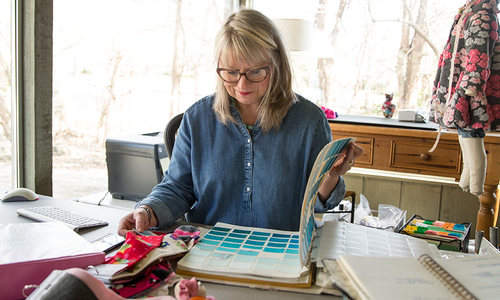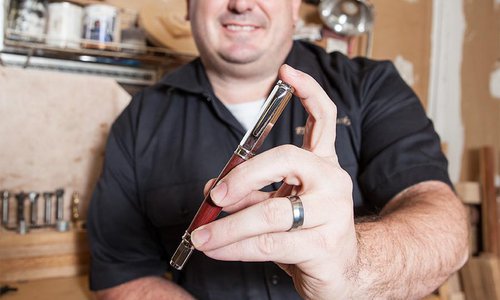
Every Anvil Customs product from leather key fobs (top right) to custom-made motorcycle seats (bottom right) is handmade by Ryan Wasson in his workshop on Park Central Square. The space is filled with rolls of multi-colored leather (center left) and tools, including the company’s namesake anvil (top left).
Ryan Wasson, owner of Anvil Customs, is a lifelong do-it-yourselfer, which is how he stumbled into starting his own business. His can-do spirit led him to try building his own motorcycle, and little did he know his biggest moneymaker was sitting right beneath him. He made and assembled each piece, including the leather seat. “By the time I was done, it was a complete failure,” he says. “The motorcycle barely would run to the end of the driveway.” As he scrapped out the parts, Wasson found that he made a profit on the seat, so he made another, and another, and another. Soon, he was making and selling leather motorcycle seats on his website.

The website-based business rapidly grew enough for Wasson to open up a workshop on Park Central Square and hire a full-time employee, Mike Shepherd. While the steadily increasing popularity has been great for the bottom line, it has also posed its own set of challenges. Although he’s a natural-born leathermaker, Wasson has had to learn how to be a business owner as he goes. For example, all of the advertising and marketing Wasson has done he has learned on the fly. He started by forming a partnership with a motorcycle magazine and then branched into Internet advertising. Wasson has learned about the effectiveness of backlinks, analytics and forums through trial and error. He found that most Google searches for “Anvil Leather” were coming from Springfield. “That’s the main reason why I opened this store here was to increase web traffic,” he says. “That will just keep getting better.”
Because he’s had to learn as he goes, he’s also had to learn how to keep up with a building backlog of orders, a task Wasson says is consistently his biggest challenge. He says the growing appeal is due to his high-quality craftsmanship and American-sourced materials, many of which come from Springfield Leather Company and Rose Metal Products in town. His one-of-a-kind artwork creates additional demand. Each hand-drawn style occurs on no more than 100 items before being retired permanently.

Wasson’s attention to detail doesn’t stop at the artwork. He factors every aspect of a great wallet—from the ease with which it slides into your pocket to its durability against the cluster of cards stretching its seams—into his design as he develops new additions to his nontraditional leather goods. “What makes my product unique is the fact that every single item is an original design,” Wasson says. To him, an original design means more than just colors and patterns. Wasson approaches his designs for belts, wallets, motorcycle seats and accessories by reassessing conventional shapes and forms and experimenting with new ways to build a classic piece.
After 10 years in business, Wasson hasn’t stopped developing his designs, and his company’s growth is proof of his success. Currently, Wasson and Shepherd can fill about 120 to 150 orders each month, but as demand rises, he hopes to hire an additional employee to help with the upcoming deluge of holiday orders. He is exploring apparel and other merchandise to add to his already extensive line of wallets, belts, chains, motorcycle seats and bags. In addition to these concrete goals, Wasson has high hopes for the company’s long-term next steps. “I kind of feel like I’m ready to be discovered,” he says. “Not bought, but supported in a way where my wallets, my designs start meeting the masses. I think it can happen. I really do think it can happen.” Based on the growth he’s seen in the past 10 years, his prediction might not be too far off.
Behind the Design: Anvil Customs
If you’ve ever looked at a product and wondered, “How did they do that?” we’ve got the answers for you. Anvil Customs owner Ryan Wasson walks you through the process of making one of his signature wallets.

It will come as no surprise that every leather product Anvil Customs creates starts from a cow—an American cow, to be specific. Once the cow has been skinned, its hide is brought to a tannery. Ryan Wasson toured the Hermann Oak Tannery in St. Louis, which supplies leather to companies such as Springfield Leather Company, where Wasson sources most of his materials. Cowhides are brought in on forklifts in 8-foot high stacks and put into chemical baths to remove the hair. They’re then taken to a vast room filled with vegetable tanning baths. The hides are clipped to underwater boats which rock the leather in a solution to go through the tanning process. When Wasson purchases the finished leather from Springfield Leather Company, he buys what are called sides, named because the leather comes from the entire side of a cow from the shoulder to the rear. In a month, Anvil Customs typically goes through about eight sides (or four cows).
Before they get started creating products, Wasson and his partner Mike Shepherd look through their list of pending orders and separate them into batches for a more streamlined process. All Puritan wallets go on one list, all belts go on another list, and so on.
The first step is selecting the leather, which Wasson ensures is all-American and never imported. His basic brown leathers come from Hermann Oak Leather or from Wickett & Craig in Curwensville, Pennsylvania. When Wasson is looking for something unusual, such as the black and gold checkerboard leather he had when we toured the shop, he turns to Springfield Leather Company who buys small-lot leathers in bulk, usually left over from large manufacturing runs of purses or other products.
When making his most popular item, the Puritan wallet, Wasson first chooses his leather—typically a plain brown—applies adhesive and then adheres a black liner. He then moves to his clicker press, an 18-ton hydraulic machine he uses to punch out the wallet shape from metal dies. “You’re not slicing,” he says. “You’re actually cookie-cutting it out of leather.” The clicker press also has dies for just about every item Anvil makes beyond wallets, including belt turn-backs, seat tops and bag parts.
After the patterns are cut, Wasson glues together the wallet parts. For some gluing projects, he uses his five-in-one to welt press the edges for a stronger hold and a cleaner finish. Once the adhesive has set, he sews up the edges in his saddle stitcher, which sits beside the smaller sewing machine used for tighter corners and more intricate work. Any item that is too thick for the stitcher or sewing machine, as is the case in several motorcycle bag designs, is thinned down using the scything machine.
From there, Wasson moves to the oldest machine in his shop, the American Line Finisher. Originally from the 1940s, the machine was used to repair shoes, shape the heels on women’s shoes, repair boot soles and polish shoes in Times Square. “Shoe repair is obsolete now, so this machine is being used differently these days,” Wasson says. In its second life at Anvil, the line finisher finishes wallet and bag edges.
Using hole punchers and rivet setters, Wasson punches holes for the wallet snaps and chain attachments. Back at the line finisher, he then applies Adam wax to the machine’s horsehair wheels to seal and polish the wallet. From there, the process is nearly complete. “I would shut the wallet, attach a chain to it, take a picture, send it to the customer and say, ‘Here it comes,’” he says. “Pretty simple.” To someone who has honed his method across a decade of training, the process might seem basic, but to anyone who holds the product of that handiwork and sees firsthand the craftsmanship involved, it’s anything but.












